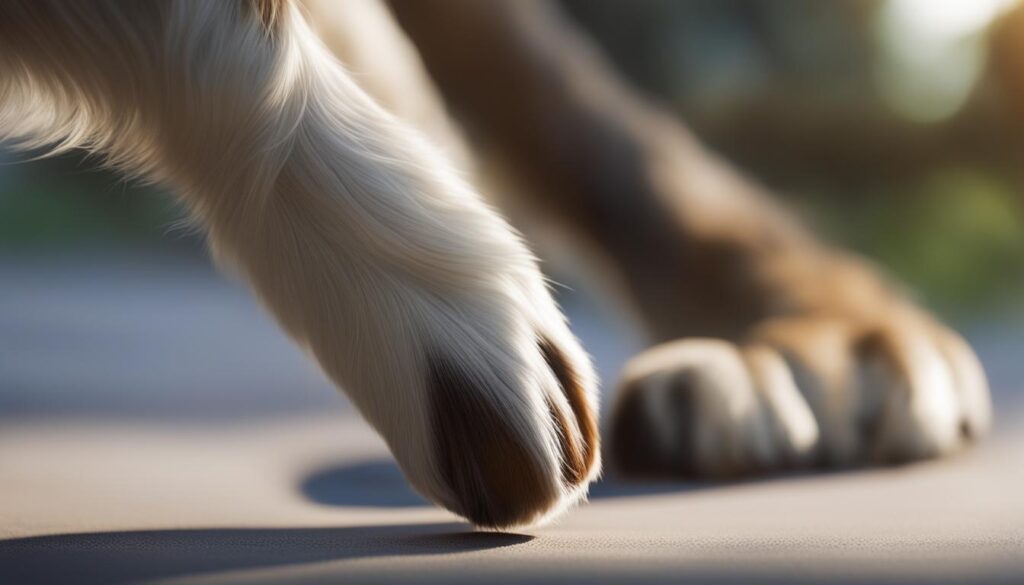Have you ever wondered why do dogs bend their paws in such unique ways? Understanding the anatomy and structure of a dog's paw can help shed light on this fascinating behavior. Dogs have a paw anatomy that differs from humans, with paw pads covering the area equivalent to the palm of our hands and toes containing three sections of bones that bend differently.
This article will delve into the reasons behind a dog's paw bending behavior, exploring the biomechanics, emotional cues, and significance of paw flexion and extension.
Key Takeaways:
- Dogs have a unique paw anatomy that allows them to bend their paws in various ways.
- The flexion and extension of a dog's paw play a crucial role in their overall movement and mobility.
- A dog's paw bending behavior can be influenced by factors such as breed, age, and overall health.
- Paw bending can sometimes indicate a dog's emotional state, including feelings of tension, fear, or relaxation.
- Observing a dog's paw bending behavior can provide insights into their physical well-being and comfort level.
The Biomechanics of Dog Paw Movement
Understanding the biomechanics of dog paw movement is key to unraveling the mystery of why dogs bend their paws. Dogs utilize their paws for a variety of activities such as walking, running, jumping, and digging. This intricate movement involves a complex coordination of muscles, tendons, and bones.
When a dog bends its paw, it employs a combination of flexion and extension movements in the joints. These motions allow dogs to adapt to different surfaces, navigate obstacles, and maintain their balance. The flexibility of a dog's paw is crucial for their overall mobility and functionality.
Table:
| Muscles | Tendons | Bones |
|---|---|---|
| Biceps femoris | Extensor digitorum longus | Metacarpals |
| Semimembranosus | Flexor digitorum superficialis | Phalanges |
| Tibialis anterior | Peroneus longus | Tarsals |
“The combination of muscle contractions and joint movements enables dogs to perform a wide range of activities, from sprinting through a field to delicately scratching their ear.”
By studying the mechanics of dog paw movement, researchers can gain valuable insights into the adaptability and agility of these remarkable animals. Additionally, understanding these biomechanics can help veterinarians diagnose and treat issues related to paw function and mobility.
Dog Foot Movement and Leg Function
The movement of a dog's foot and its leg function are closely intertwined. The coordinated action of the muscles, tendons, and bones in the foot and leg allows dogs to achieve smooth and efficient movement.
During walking or running, dogs land on their paw pads, which act as shock absorbers and provide traction. The toes flex and extend to grip the ground, providing stability and propulsion. This intricate foot movement, combined with the coordinated action of the leg muscles, allows dogs to generate the necessary force to propel themselves forward.
Overall, understanding the biomechanics of dog paw movement and leg function provides valuable insights into the remarkable agility and adaptability of dogs. It also underscores the importance of proper paw care to ensure the overall well-being and mobility of our furry companions.
Understanding Paw Bending Behavior in Canines
When it comes to our furry friends, dogs have a unique way of bending their paws. This behavior can be influenced by various factors such as breed, size, age, and overall health. Observing a dog's paw bending behavior can provide valuable insights into their physical well-being and emotional state.
Dogs may bend their paws as a way to stretch their muscles, relieve tension, or find a comfortable resting position. It can also be a natural behavior during play or when interacting with their environment. By paying attention to their paw bending, you can gain a better understanding of their needs and overall comfort level.
Understanding the mechanics behind a dog's paw bending is crucial. It involves a combination of flexion and extension movements of the joints, allowing dogs to adapt to different surfaces, maintain balance, and perform various tasks. The range of motion in a dog's paw joints enables them to engage in activities like running, jumping, and climbing.
It's important to note that paw bending behavior can also reflect a dog's emotional state. Dogs may lift their paws when feeling anxious, conflicted, or anticipating something. On the other hand, a relaxed and comfortable posture, often accompanied by paw bending, is a sign of a calm and content dog. By observing their overall body language and context, you can interpret their paw bending behavior in a more accurate manner.
Key Takeaways
- Dogs bend their paws for various reasons, including stretching, relieving tension, and finding comfort.
- Paw bending behavior can be influenced by factors such as breed, size, age, and overall health.
- Understanding the mechanics of paw bending involves a combination of flexion and extension movements of the joints.
- Paw bending behavior can also reflect a dog's emotional state, with lifting paws indicating anxiety or anticipation.
The Significance of Paw Flexion and Extension


When it comes to a dog's movement and mobility, the flexion and extension of their paws play a crucial role. Paw flexion refers to the bending or curling of the paw, while paw extension involves the stretching or straightening of the paw. These movements may seem simple, but they enable dogs to adapt to different surfaces, maintain balance, and perform a wide range of activities.
The flexibility of a dog's paw joints allows for a remarkable range of motion. This incredible dexterity enables dogs to engage in activities such as running, jumping, climbing, and even scratching an itch. Whether they're maneuvering through different terrains or engaging in playful antics, the ability to flex and extend their paws is an essential component of a dog's physical capabilities.
“The range of motion in a dog's paw joints allows for a wide range of activities.”
But it's not just about physical functionality – paw flexion and extension can also provide insights into a dog's emotional state. Dogs may bend their paws in different ways depending on their feelings and the specific context. For example, paw lifting can be a sign of anxiety, tension, or anticipation, while relaxed and comfortable postures often involve paw bending as well.
Understanding the significance of paw flexion and extension is key to interpreting a dog's body language and overall well-being. It allows us to appreciate the incredible mechanics behind their behavior and deepen our connection with our furry companions.
The Relationship Between Paw Bending and Emotional State


Dogs have unique ways of communicating their emotions, and one fascinating behavior to observe is how they bend their paws. Paw bending can provide valuable insights into a dog's emotional state, signaling both positive and negative feelings. By paying attention to this behavior and considering the overall context, you can better understand your furry friend's needs and emotions.
When a dog lifts its paws, it can be an indication of anxiety, conflict, or anticipation. This behavior may manifest during stressful situations or when the dog is unsure about its environment. Paw lifting can be accompanied by other body language cues, such as a lowered tail, flattened ears, or a tense body posture. It is essential to provide reassurance and create a safe space for your dog during these moments, helping them feel more relaxed and secure.
On the other hand, dogs also bend their paws as part of a relaxed and comfortable posture, especially when they are sleeping. A dog curling up with its paws tucked in can signal a sense of warmth, protection, and contentment. This position is often seen when dogs feel safe and secure in their environment. Observing your dog's sleeping positions can offer valuable insights into their overall well-being and comfort level.
“A dog's paw bending behavior can be a valuable indicator of their emotional state. Whether it's a sign of anxiety or relaxation, paying attention to this behavior can deepen your bond with your furry companion.”
It's essential to remember that each dog is unique, and their paw bending behavior may vary. Some dogs may exhibit paw bending more prominently, while others may not display it as frequently. To accurately interpret your dog's emotional state, it's crucial to consider their entire body language and the specific context in which the behavior occurs.
By understanding the relationship between paw bending and emotional state, you can develop a stronger connection with your dog and provide them with the care and support they need. Remember to create a safe and comforting environment, pay attention to their body language cues, and seek professional guidance if you have concerns about your dog's emotional well-being.
Common Dog Sleeping Positions and Their Meaning


Dogs have various sleeping positions, and each position can convey different meanings. By observing your dog's sleeping position, you can gain insights into their overall well-being and comfort level. Let's take a closer look at some common dog sleeping positions and what they might indicate:
Curled up in a ball: This position is often seen when dogs are seeking warmth and protection. By curling up, they conserve body heat and create a sense of security.
Lying on their side with legs extended: When dogs sleep on their side with their legs outstretched, it's a sign that they feel safe and relaxed in their environment. This position allows them to fully stretch out and rest comfortably.
Sleeping on their belly: Dogs who sleep belly-up are showing complete relaxation and trust in their surroundings. This position exposes their vulnerable belly, indicating a deep sense of comfort.
Sphinx position: Working or guard dogs often sleep in the sphinx position, with their front legs stretched out and their hind legs bent. This position allows them to quickly spring into action if needed.
Superman position: Puppy sleep behavior often includes the superman position, where they lie on their belly with all four legs stretched out. This position helps puppies cool down and relax after playtime.
Remember, each dog is unique, and their sleeping position may vary based on factors such as breed, age, health, and personal preference. Paying attention to your dog's sleeping position can help you better understand their needs and emotions. It's just another way to strengthen the bond between you and your beloved canine companion.
| Sleeping Position | Meaning |
|---|---|
| Curled up in a ball | Seeking warmth and protection |
| Lying on their side with legs extended | Feeling safe and relaxed |
| Sleeping on their belly | Complete relaxation and comfort |
| Sphinx position | Ready for quick action, often seen in working or guard dogs |
| Superman position | Cooling down and relaxing, common in puppies |
“A dog is the only thing on earth that loves you more than you love yourself.” – Josh Billings
Conclusion
Dogs have a fascinating paw behavior that can be influenced by various factors, such as biomechanics, emotional state, and comfort. Understanding the anatomy, movement, and behavior of a dog's paws is crucial in comprehending their overall well-being. By observing their paw bending behavior, along with other body language cues, you can develop a deeper bond with your furry companion and ensure their happiness.
The flexion and extension of a dog's paws are essential for their mobility and functionality. When a dog bends its paw, it utilizes a combination of flexion and extension movements to adapt to different surfaces, maintain balance, and perform various tasks. This unique paw flexibility enables dogs to run, jump, climb, and even scratch an itch with ease.
Beyond the physical aspect, a dog's paw bending behavior can also communicate their emotional state. Paw lifting may indicate anxiety or uncertainty, while relaxed and comfortable postures are displayed during sleep. By paying attention to a dog's overall body language and context, you can better interpret the meaning behind their paw bending behavior.
Next time you witness your dog bending its paws, take a moment to appreciate the complex mechanics behind this behavior. Understanding your dog's paw behavior and body language will help strengthen the bond you share, ensuring their happiness and well-being.
FAQ
Why do dogs bend their paws?
Dogs bend their paws to adapt to different surfaces, navigate obstacles, and maintain balance. Paw bending is a natural behavior that allows dogs to perform various movements such as walking, running, jumping, and digging.
What is the biomechanics of dog paw movement?
The biomechanics of dog paw movement involve the coordination of muscles, tendons, and bones. Dogs use a combination of flexion and extension movements in their paw joints to bend their paws. This flexibility is crucial for their overall mobility and functionality.
What factors influence a dog's paw bending behavior?
Various factors such as breed, size, age, and overall health can influence a dog's paw bending behavior. Dogs may bend their paws to stretch their muscles, relieve tension, find a comfortable resting position, or as a natural behavior during play or interaction with their environment.
What is the significance of paw flexion and extension?
Paw flexion and extension play a crucial role in a dog's overall movement and mobility. These movements enable dogs to adapt to different surfaces, maintain balance, and perform various tasks such as running, jumping, climbing, and scratching an itch.
Can paw bending indicate a dog's emotional state?
Yes, the way a dog bends its paws can sometimes indicate its emotional state. For example, lifting their paws may be a sign of tension, fear, or uncertainty. On the other hand, relaxed and comfortable paw bending can be observed during sleep or in a relaxed posture.
What do different dog sleeping positions mean?
Different dog sleeping positions convey different meanings. For example, a curled-up position may indicate seeking warmth and protection, while sleeping on their side with legs extended often indicates feeling safe and relaxed. Belly-up indicates complete relaxation, and certain positions are common among specific breeds or puppies.
How can observing paw bending behavior benefit pet owners?
By observing a dog's paw bending behavior, along with other body language cues, pet owners can gain insights into their pet's physical well-being and emotional state. It helps develop a deeper connection with their dogs and ensures their overall well-being.





